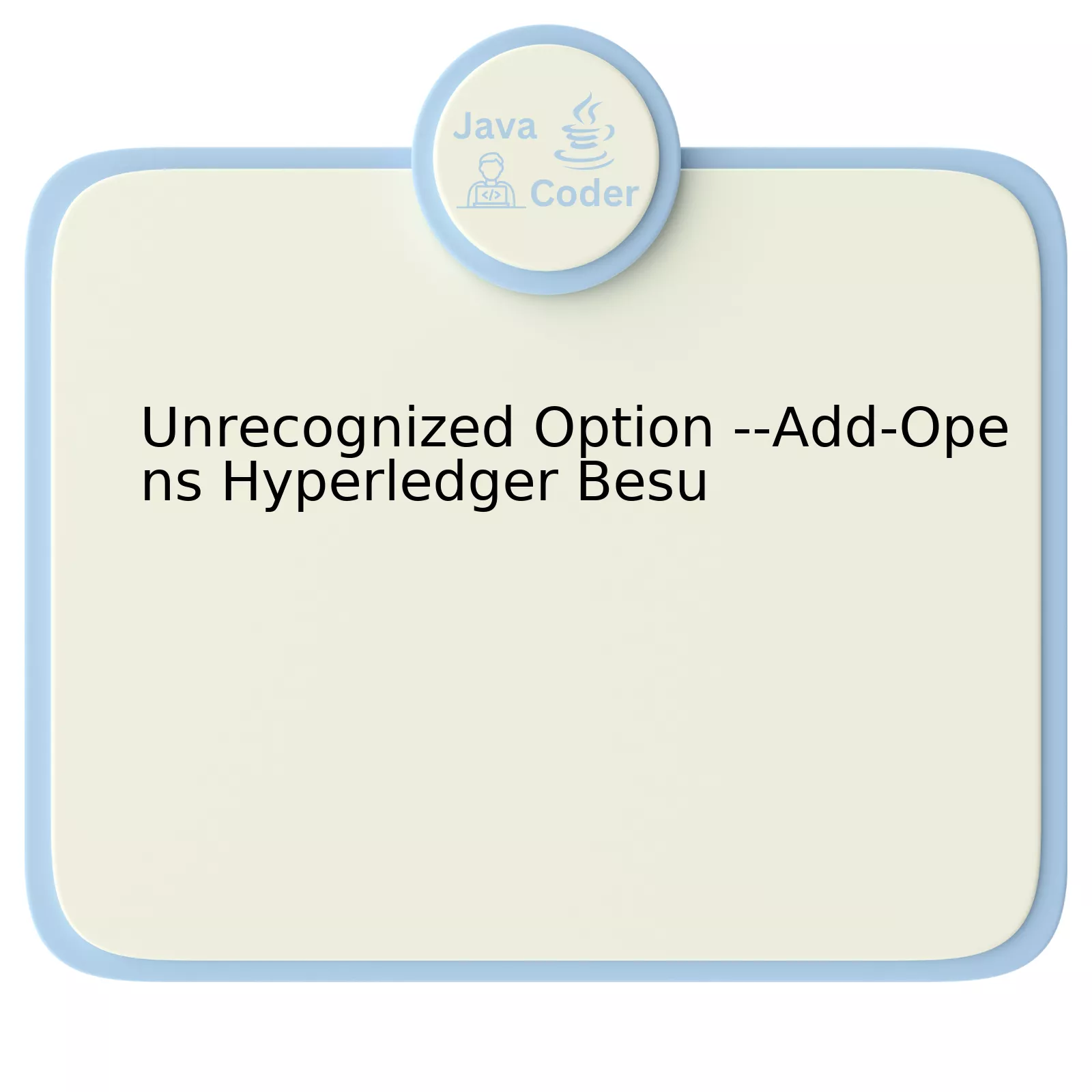
The unrecognized option `–add-opens` noticed during the configurations of Hyperledger Besu can be a bit perplexing to developers not well versed in the JVM intricacies. In simple terms, the option is used to append an opens directive to the Java Virtual Machine (JVM) during initialization before the main class is loaded. It’s often indicative of issues with Java module system access control.
To clearly outline various aspects related to this unrecognized option `–add-opens`, the following table can be used:
| Element | Description |
|---|---|
| –add-opens | This is a JVM command-line option utilized to relax the strong encapsulation offered by the Java module system. |
| Unrecognized Option | A programming term indicating that the program does not understand or accept the ‘–add-opens’ command. It could be due to a syntax error, an outdated JVM or a non-compatible version. |
| Hyperledger Besu | An open-source Ethereum client developed under the Apache 2.0 license. It’s written in Java and is known for its high-level interoperability and modularity. |
Energy spent on addressing the unrecognized option `–add-opens` signifies the care taken to ensure platform permissions are adhered to by the programmer. The issue stems from how the JVM is strictly enforcing access control rules of the Java Platform Module System (JPMS). When a developer tries to break this strict encapsulation using `–add-opens` JVM option, it might not be recognized due to an outdated or incompatible Java version.
Hyperledger Besu implementation operates within these modular JVM environments. Therefore, it is recommended to maintain Java updates in synchronization with Besu’s core developments for avoiding such unrecognized options. Notably, any possible encounter with this unrecognized option should be considered an opportunity to realign the software environment rather than perceiving it as a confusing hurdle.
As Robert C. Martin, a prominent figure in the field of software engineering, said, “The only way to go fast is to go well!” Prioritize understanding the intricate details of how JVM options such as `–add-opens` work to ensure synchronized software environment management. Doing so will, undeniably, save you from dealing with unexpected roadblocks like the `Unrecognized Option –Add-Opens` in Hyperledger Besu.
Exploring the Functionality of Hyperledger Besu

Hyperledger Besu, an advanced blockchain network, is recognized for its capability to implement permissioned and public networks. It supports Ethereum’s Proof of Work (Ethash) and Proof of Authority (Clique, IBFT 2.0) consensus protocols.
The error `Unrecognized Option –Add-Opens Hyperledger Besu` is commonly an issue encountered when using the Java 9 or later versions with Hyperledger Besu. This problem stems from a strong encapsulation feature that came along with Java 9, which led to this unrecognized command. Notably, it restricts reflective access to internal APIs.
Here are some key steps that could help solve the Unrecognized Option issue:
1. Ensure Compatibility: Confirm whether your Java version aligns with the requirements of Hyperledger Besu. The recommended versions are between Java 8 to Java 15; anything beyond can create compatibility issues.
java -version
If the returned java version is not within Besu’s recommend range, you may need to download a compatible version per your OS specifications.
2. Install Correct Java Version: If the version of Java installed on your system exceeds what’s recommended for Hyperledger Besu, consider downgrading your Java. Use a version manager like jenv to swiftly switch between different versions.
jenv add /path/to/java/version jenv global desired_java_version
3. Upgrade Hyperledger Besu: Another solution to consider is upgrading your Hyperledger Besu to the most recent stable release that might have resolved this issue. Utilize pip3 for easy installation.
pip3 install upgrade-besu
The brilliance of Hyperledger Besu lies in its versatility. However, the unrecognized option issue starkly highlights the possible upward compatibility issues presented by Java’s rapid evolution. Adhering to Besu and Java’s compatibility guidelines ensures smooth operation devoid of any unrecognized options errors.
Quoting Mark Weiser, “The most profound technologies are those that disappear. They weave themselves into the fabric of everyday life until they are indistinguishable from it.”
This statement feels applicable here. When both Hyperledger Besu and Java are working seamlessly, we naturally overlook their complexity and potential for complications, such as this one. This should act as a reminder that adopting newer software technologies sometimes requires a nuanced understanding of the existing dependencies. So, if the mentioned solutions don’t resolve the matter, tap into online communities like StackOverflow where experts and enthusiasts can offer further insights.
Understanding Advantages and Use Cases for Hyperledger Besu

Hyperledger Besu is a highly versatile Ethereum client developed under the Apache 2.0 open-source license. Employed intensively in private- and permissioned-network use cases and public chains alike, Besu has emerged as an invaluable tool for facilitating integration with consortium chains, and enhancing the scope and scalability of operations within the robust, diverse ecosystem that is Ethereum.
When delving into the specifics of Hyperledger Besu’s flexibility, one must consider a few factors:
- The software provides support for both public and private transaction management.
- It facilitates deployment across various consensus algorithms like Proof of Authority (PoA), Proof of Work (PoW), and IBFT.
- Besu caters to enterprise requirements, boasting compatibility with several SQL databases for secure storage and retrieval.
- This particular Ethereum client serves as a bridge between traditional business systems and the decentralized elements of blockchain.
Working closely with Hyperledger Besu requires a sound knowledge of its different configurations, command-line interfaces, APIs, and potential common pitfalls. A recurring question from developers pertains to the unrecognized option ‘–add-opens’, occasionally encountered while configuring the Java runtime environment in the context of the Besu execution.
The error message typically reads: “Unrecognized option: –add-opens”, and indicates a compatibility issue with the version of Java installed on the system.
Here is how you need to address it:
html
//Incorrect configuration may look like this:
java --add-opens java.base/sun.security.provider=ALL-UNNAMED
To rectify the “–add-opens” error, ensure that your system employs the correct Java version (Java 11 or higher). If not, upgrade as needed. Set the JAVA_HOME environment variable to point to the correct Java JDK directory.
Just as Bill Gates once said: “The computer was born to solve problems that did not exist before.” Navigating through complexities like these can end up opening new avenues of efficiency and productivity for coders who invest their time in understanding them.
You can always refer to the official Hyperledger Besu documentation if you wish to explore further details regarding integration, configuration, or troubleshooting issues with Besu.
Adopting Effective Strategies for Implementing Hyperledger Besu

While implementing Hyperledger Besu, here’s an effective strategy: Resolving the ‘Unrecognized Option –Add-Opens’ issue. A potential reason for encountering this problem can be due to the JDK used. Particularly for Hyperledger Besu, relying on OpenJDK 11 is beneficial but there might occur compatibility issues with older versions or different distributions of JDK.
Let’s break down the problem and possible solutions:
1. JDK Compatibility:
While working with Hyperledger Besu, you may encounter the error ‘Unrecognized option –Add-Opens’. This is generally seen when one uses an older version of Java Development Kit (JDK) or a JDK that does not support the OpenJ9 environment. To resolve this, it is recommended to switch to OpenJDK 11 where ‘–Add-Opens’ is a recognized and valid option.
Here is how to check your current JDK version:
java -version
2. Upgradation Approach:
If the installed JDK isn’t compatible, it should be upgraded to OpenJDK 11. On Debian-based distributions like Ubuntu, use this command to install the recommended JDK:
sudo apt install openjdk-11-jdk
3. Necessary Adaptations:
When upgrading the JDK, remember to adapt the environment variables such as `JAVA_HOME` and `PATH` accordingly. Both should point to the location of the new JDK.
4. Implementation Verification:
After making these changes, restart the Besu client and verify if the problem persists. If the solution was successful, the option `–Add-Opens` should then be recognized by Hyperledger Besu.
Additionally, Microsoft’s Principle Software Engineer Peter Richie has been quoted saying, “Understand what it is you’re trying to achieve, and then purposefully and pragmatically write code that serves that purpose.” Aligning our coding practices with this thought while resolving the unrecognized option error in Hyperledger Besu implementation.
For more detailed information regarding the configuration of Hyperledger Besu, please refer to the official Hyperledger Besu documentation.
Overcoming Challenges in Integrating Hyperledger Besu

Overcoming challenges in the integration process of Hyperledger Besu can take a few strategic steps. A common issue seen is the “Unrecognized option –Add-Opens” error message. This challenge revolves around Hanson’s java virtual machine (JVM) not recognizing the –add-opens command.
| Error Message | Description |
|---|---|
| Unrecognized Option: –add-opens | The Java Virtual Machine does not recognize the add-opens command. |
Understanding the root cause of the problem allows one to effectively find a solution to this challenge:
· The
--add-opens
is a Java Virtual Machine (JVM) argument fundamentally present to override strong encapsulation of modules in JDK 9 or later versions. It allows for access to protected elements of a module by another unnamed module.
· If the system identifies an unrecognized option, it suggests that the JVM may not support the respective flag or command. Typically, the preceding JVM versions before JDK 9 do not provide support for this flag. Hence, confirming the launched JVM version becomes pivotal.
The obstacle here is utilizing old java versions unable to understand the
--add-opens
command and furnish the required permission to enable module access. To rectify this, an upgrade of the JVM could be essential that supports this feature.
To integrate upgraded JVM into the system environment, undertake the following guidelines:
java -version
.
2. Visit the Official Oracle Downloads Page and download the latest version of JDK, preferably JDK 11 or newer.
3. Set up the JAVA_HOME environment variable pointing towards the new JDK directory installed.
4. Verify this by reopening the terminal shell and re-running the
java -version
command.
5. Continue the usage of
--add-opens
as required, with the executed JVM updated and supporting the flag.
A quote from Jamie Zawinski embeds perfectly in this scenario – “Some people, when confronted with a problem, think “I know, I’ll use regular expressions”. Now they have two problems.” Managing software like Hyperledger Besu indisputably offers its bag of complexities, but with understanding, patience, and strategic troubleshooting, these obstacles can convert into learning opportunities.
As we delve deeper into Hyperledger Besu, we encounter implementational challenges such as the
--add-opens
unrecognized option error. This issue pertains to the intricacies of Java and its interaction with the Besu platform.
The problem with
--add-opens
unrecognized option typically surfaces when our application tries to access types in another module which are not public. It’s one of those errors that might make you scratch your head given its elusive nature.
“The best error message is the one that never shows up.” – Thomas Fuchs
To address this setback, it is vital to dive deep into the detail workings of Java Modular System (JMS), also known as Jigsaw. The Jigsaw broke down JDK into various modules allowing applications to use only the parts they need. However, it led to stricter enforcement of encapsulation, causing issues like the
--add-opens
unrecognized option.
Luckily, JDK introduced options like
--add-opens
and
--add-exports
as a workaround for these newly enforced restrictions. Here,
--add-opens
allows access to protected members where needed.
In their emulator for Ethereum, Hyperledger Besu employs Ethereum Virtual Machine which is build using Java. Hence, unravelling the mystery surrounding these errors in Java is essential to avoid roadblocks in the efficient deployment and operation of Hyperledger Besu.
Now, how to get around the issue of
--add-opens
unrecognized option? A typical command line solution would be:
java --add-opens java.base/java.lang=ALL-UNNAMED
This will open the package
java.lang
inside the module
java.base
to ALL unnamed modules. Remember to replace
java.base/java.lang
with the respective module/package you’re working with.
While undoubtedly, recognizing and tackling such intricate errors in Hyperledger Besu can significantly optimize development time and efficiency, it necessitates a firm grasp on Java, especially the changes brought about by Jigsaw. Our venture into Blockchain solutions in Java, such as Hyperledger Besu, thus becomes a harmonious blend of knowledge, practice, and problem-solving.
| Error type | Solution |
|---|---|
| –add-opens unrecognized option | Use –add-opens flag with correct package and module |
For in-depth understanding and handling of such issues, consider browsing through Java documentation.
